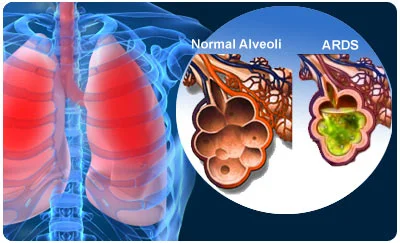Acute Respiratory Distress Syndrome
/What is it?
Acute respiratory distress syndrome is the sudden failure of the respiratory system, or breathing. It can occur in anyone who is critically ill with a different illness or who is suffering from major injuries. Most people who develop this syndrome are already being hospitalized for something else. The most common symptoms people experience are quick breathing, low levels of blood oxygen, and trouble getting enough air when breathing.
Acute respiratory distress syndrome can be life-threatening as the proper amount of oxygen is necessary to maintain body function. Your body relies on oxygen, and oxygen-rich blood for organs to function properly and efficiently. Without this distribution of oxygen from the lungs, the organs can begin to shut down. In acute respiratory distress syndrome, the blood vessels within the lungs, leak more than normal amount of fluid into the air sacs where oxygen exchange occurs. This excess fluid prevents the lungs from filling with air and transferring oxygen into the blood stream.
This syndrome can create permanent lung damage for some sufferers, while others may recover completely with little to no permanent damage. Luckily for those who are afflicted by acute respiratory distress syndrome, treatment has greatly improved over recent years and survival rates are increased compared to the past.
Acute Respiratory Distress Syndrome Quick Facts:
Symptoms:
· Difficulty breathing
· Rapid breathing
· Severe shortness of breath
· Low blood pressure
· Confusion
· Extreme fatigue
· Organ failure
Statistics:
· Approximately 190,000 Americans are affected by ARDS annually.
· Up to 30% of ARDS cases can be fatal.
o 20 years ago the death rate was 50%-70%
· More fatal for patients who develop syndrome because of sepsis, compared to trauma or lung infection.
· Lung function can return to normal or near normal within a few month for most people.
· Possibility of lasting lung damage.
Causes:
· Sepsis
· Trauma
· Pneumonia/Lung infection
· Blood transfusions
· Inhaling harmful smoke
· Inhaling vomit into lungs
· Inhaling salt water
· Narcotics
· Sedatives
Diagnosis and treatment:
If you suspect you are suffering from acute respiratory distress syndrome, a clinician with listen for abnormalities in breathing, heart rate, and excess body fluid. They may run a serious of tests to try to conclude if there is fluid in the lungs or if some other type of illness may be causing the breathing problems.
Medical tests include:
· Arterial blood gas test: checks the oxygen level in blood
· Chest x-ray: checks for extra fluid in lungs
· Blood tests: to check for infection that may be causing respiratory syndrome
· CT scan: can check for abnormalities in the lungs
· Cardiac tests: Analyze and examine for heart failure which can cause fluid in the lungs.
There is no specific treatment for this syndrome, but typical management occurs through the use of oxygen supplementation or therapy. This might mean breathing assistance with mechanical ventilation, or transfusing oxygenated blood into the patient.
Some other treatments may include:
· Oxygen tubes through the nose or through a mask
· Oxygen through a breathing tube, and ventilator
· IV fluids to improve blood flow and to provide nutrition to the bodily organs
· Medicine to prevent and treat infections and manage pain

